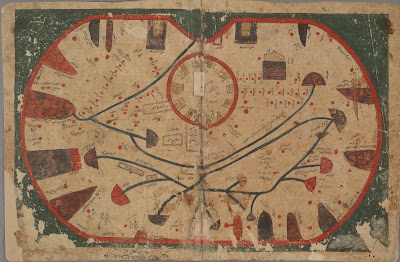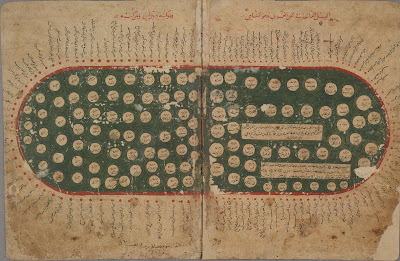'Kitāb Gharāʾib al-funūn wa-mulaḥ al-ʿuyūn'
(The Book of Curiosities of the Sciences and Marvels for the Eyes)
(The Book of Curiosities of the Sciences and Marvels for the Eyes)

Diagram of the Encompassing Sphere or Universe [pdf legend]
{Looks like this link won't work because of a session timer - seems you have to
click on the link below each map at the site (9 pages of thumbnails)}
{Looks like this link won't work because of a session timer - seems you have to
click on the link below each map at the site (9 pages of thumbnails)}

[The oldest extant] Rectangular Map of the World

Circular World Map

Sicily Map

Sources of Nile

Diagram of Winds
{from the chapter, 'On the blowing of winds, earthquakes and tremors'}
{from the chapter, 'On the blowing of winds, earthquakes and tremors'}

Tigris Map

Indus Map

Indian Ocean Map

Mahdiyah Map (Tunisia)
(this picture has been turned 90 degrees)
(this picture has been turned 90 degrees)

Mediterranean Map

Caspian Sea Map

Illustration of a Waq-Waq Tree
"The Waq Waq are mythical lands, associated with trees bearing humanoid fruits, which were sometimes located in Africa and sometimes in the eastern Indian Ocean."The Bodleian Library at the University of Oxford has launched a fascinating and detailed website presentation of 'The Book of Curiosities'.
Composed in Egypt in the first half of the 11th century, this recently discovered 12th/13th century cosmographical manuscript contains highly unique celestial and terrestrial maps, including the first known rectangular map of the world produced before the renaissance [I believe this has the first known map reference to England: 'Angle Terre']. The geographical references are based largely on the first century work of Ptolemy but the manuscript contains previously unknown distinct cartographic features.
In conjunction with the maps, the text provides insight into the customs and beliefs of the people and details about the commerce and trade routes in the Islamic Empire just prior to the start of the Crusades.
'The Book of Curiosities' is actually divided between 2 books (the universe and earth), and at the time of its purchase by the Bodleian in 2002 it was described as the most important Islamic scientific manuscript to have come onto the market in the last century. The whole of book 2 (earth) and parts of book 1 are presented in high resolution format with mouseover translations, arabic and english pop-up transcriptions as well as footnotes and map legends. I spent more than an hour just browsing around before downloading some sample images.
All of the maps (except the one I rotated) have north at the bottom. Why?
See also: cartography / Arabic.


11 comments :
Hi, thanks for another great post! Unfortunately the server returns an error when clicking for the legends: “ERROR: Your session has timed out or you are not logged in”
How can we reach the pdfs?
Bye,
Marco
Sorry about that Marco - I've taken those legend links out. Just go to the site and choose 'thumbnails', then choose a map and click on it and the link to the legend is below each map.
Thanks,
Marco
this is a wild and uneducated guess, but could it possibly have something to do with the Nile flowing northward, maybe influencing their concept of top and bottom?
That's sounds about logical enough for me Daan.
Well, this link says (under 'Round the World'):
"Arabia (Ancient): They put south at the top. This is because when you wake up and face the sun, south is on the right. Because of positive associations with the right as opposed to left, they put that on top. Yemen is so named because it is on the "yamin" right of Arabia. And of course, with the sea to the south of them there was nothing "on top" of the country, so they prefered it that way. Europeans learnt mapmaking from the Arabians and flipped the map to make themselves on top. [ Source: email from Jessica who heard a talk by an American Muslim scholar called Hamza Yusuf. ]"
I don't know if this is what you might call, an authority however.
Or were the original cartographers from NZ or Oz?
Read all about map-making and the haptic sense in the works of Yi-fu Tuan. Why some of the first map-makers in many cultures did what they did is one of the most profound human stories.
Thanks for these images -- they're nothing if not enigmatic, and they suggest the ferocious desire of the medieval map-maker, and the culture he represented, to fit any data into a preconceived shape -- oh, not that we're like that anymore... One of the most marvelous things about old maps is that they remind us of the certain -- though perhaps invisible to everyone -- limits of our current point of view: we are not more right than they were 1,000 years ago, only wrong in ways the future will know best. This is a humbling lesson in any discipline, but it is never more graphic than in the contemplation of old maps of foreign parts.
Thanks again for the beautiful and moving light show, late at night...
PK, this is simply beautiful and rare. thanks for sharing
couldn't agree more with Elatia Harris sayings.
and if i may add that i wonder what happen to the amazing curiosity and inventions that populated the Arab world those days, it seems that for the last centuries they have turned their back against this amazment of the universe secrets and beauty
btw
i can't seem to enter the link of the Bodleian Library.
Yes. Well said Elatia.
Moon, I'm sure that is a temporary glitch - you can read the Oxford press release about the manuscript while you're waiting.
These are amazing mate, where can I find hard copies?
I found you looking for Islamic map illustrations, previously I've only seen them in sales catalogues. I nipped into Christies a couple of years back (curiosity overcame my fear) and saw a gorgeous ancient Indian map (it may have been Hindi but I forget) it was accompanied by some lovely illustrated manuscripts and I've been on the hunt for them ever since. Books and places to look for images would be gratefully received.
Wonderful blog. Cheers.
Ben
Thanks for the kind words Ben.
To be honest, your enquiry about hard copies is pretty open-ended. Amazon, Ebay, Christies & Sotheby's websites (at the very least) offer up great specificity in their search engines. It then depends on whether you want books or posters and if you want great accuracy or cheaper facsimie reproductions or the like. In any event, I'm not your man in terms of solid advice from that point of view. I tend to be more edumacated about the web properties. So good luck with it!
Post a Comment
Comments are all moderated so don't waste your time spamming: they will never show up.
If you include ANY links that aren't pertinent to the blog post or discussion they will be deleted and a rash will break out in your underwear.
Also: please play the ball and not the person.
Note: only a member of this blog may post a comment.